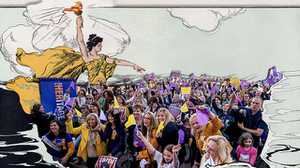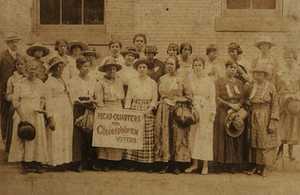How Moderate and Militant Suffragists Fought the System—and Each Other
The history of social movements is full of anecdotes about activists who clashed, often strongly, over the best methods for achieving a shared goal. Women’s suffrage is no exception.

This article is part of She Resisted, an interactive experience celebrating the pioneering strategies of the women’s suffrage movement.

When the leaders of two of the country’s foremost suffrage organizations met, discord was a matter of course. Carrie Chapman Catt, head of the National American Woman Suffrage Association (NAWSA), and Alice Paul, president of the National Woman’s Party (NWP), were once allies. Over time, however, they and their respective organizations diverged, sharply. Parting ways in 1915, at the end of a summit meant to smooth over their differences, Catt told Paul, “I will fight you to the last ditch!” leaving their differences unresolved.
The tension between NAWSA and the NWP resulted from differences over the best way to effect change. NAWSA was the more mainstream of the two organizations; it also boasted the far larger membership (2,000,000 vs NWP’s 50,000 members). In many ways, the NWP was the younger sibling of the two. The National Woman’s Party was formed out of a NAWSA planning committee that eventually split away from its parent organization over differences in strategy. Many of the NWP’s members were former NAWSA constituents who had defected, and the group’s leaders were a younger generation of suffragists who had grown tired of the more moderate tactics employed by previous activists.

Many of the suffrage movement’s most public actions—picketing of a wartime president and voluntary imprisonment among them—were products of the National Woman’s Party strategic plan and its more confrontational, militant form of activism. Paul and the NWP intentionally provoked the public with highly visible, dramatic actions that attracted media attention. Both organizations, however, practiced a politics of convenience where race was concerned: they allied with suffragists of color where their support was advantageous but otherwise defaulted to racist viewpoints and racial exclusion. Black women insisted nonetheless on being included in the two mainstream organizations whenever possible. Even as they called for their own enfranchisement, Black women always advocated for the voting rights of Black men.
Beyond disagreements on tactics, the two organizations were also at odds over a central question of strategy: whether to pursue votes for women state by state or fight for a federal amendment. For most of its history, NAWSA preferred the state-by-state approach, whereas the NWP was formed expressly to win a federal amendment. Both organizations eventually converged on the common cause of a constitutional amendment, but only after that goal had gained widespread momentum. The 19th Amendment was ultimately successful because of both of their efforts and because of the relentless work of many other allies in the struggle for equality.








